Impact Assessment of Hydrate Cuttings Migration and Decomposition on Annular Temperature and Pressure in Deep Water Gas Hydrate Formation Riserless Drilling
Abstract
1. Introduction
2. Model Development
- (1)
- Hydrates contained in cuttings are regarded as methane hydrate.
- (2)
- The area of any flow section is equal to the sum of the areas occupied by the three gas–liquid–solid phases.
- (3)
- Methane hydrate is evenly distributed in hydrate cuttings.
2.1. Hydrate Phase Equilibrium and Phase Transition Rate Model
2.2. Multiphase Flow Model
2.3. Heat Transfer Model
2.4. Hydrate Cuttings Slip Model
2.5. Definite Solution Conditions and Model Solution
3. Engineering Background and Calculation Parameters
4. Results and Discussion
4.1. Annular Temperature and Pressure Distribution along with Drilling Time
4.2. Influence of Drilling Fluid Inlet Temperature
4.3. Influence of Drilling Fluid Displacement
4.4. Influence of Drilling Fluid Density
4.5. Influence of Penetration Rate
5. Conclusions
- (1)
- Compared to drilling the three-phase layer, the annulus temperature and pressure change caused by the decomposition of hydrate cuttings is more obvious when drilling the hydrate layer.
- (2)
- When the inlet temperature of the drilling fluid is 20 °C, the annulus phase transition is mainly hydrate generation by free gas. However, the generation rate is very low, and the influence on the annulus temperature and pressure can be ignored. When the inlet temperature of the drilling fluid is 24 °C and 28 °C, the annulus phase transition is mainly the decomposition of hydrate cuttings. The influence of hydrate cuttings decomposition on the annulus temperature and pressure increases significantly with the increase in inlet temperature.
- (3)
- The annulus temperature and pressure increase significantly with the increase in drilling fluid displacement, while the influence of hydrate cuttings decomposition on temperature and pressure decreases with the increase in displacement.
- (4)
- Due to the double gradient effect of riserless drilling, a small range of variation in the ROP and drilling fluid density have little impact on the annulus pressure but mainly on the annulus temperature. When drilling without a riser, the change in displacement has a significant impact on the annular pressure, and the inlet temperature of the drilling fluid has the smallest impact on the annular pressure, while the inlet temperature of the drilling fluid has the greatest impact on the annular temperature. The influence of hydrate cuttings decomposition on the annulus temperature and pressure increases with the increase in ROP.
- (5)
- In normal drilling conditions, hydrate cuttings decomposition has little impact on the annulus temperature and pressure, but under the conditions of a high drilling fluid inlet temperature (above 28 °C in this study), high hydrate saturation (above 31% in this study), low drilling fluid displacement (less than 30 L/s in this study), and a high penetration rate (above 35 m/h in this study), it is necessary to consider the impact of hydrate cuttings decomposition on annulus temperature and pressure.
Author Contributions
Funding
Data Availability Statement
Conflicts of Interest
References
- Wu, N.; Li, Y.; Chen, Q.; Liu, C.; Jin, Y.; Tan, M.; Dong, L.; Hu, G. Sand Production Management during Marine Natural Gas Hydrate Exploitation: Review and an Innovative Solution. Energy Fuels 2021, 35, 4617–4632. [Google Scholar]
- Li, Q.; Zhao, D.; Yin, J.; Zhou, X.; Li, Y.; Chi, P.; Han, Y.; Ansari, U.; Cheng, Y. Investigation on Sediment Instability Caused by Gas Production from Hydrate-Bearing Sediment in Northern South China Sea by Horizontal Wellbore: Evolution and Mechanism. Nat. Resour. Res. 2023, 32, 1595–1620. [Google Scholar] [CrossRef]
- Yin, F.; Gao, Y.; Chen, Y.; Sun, B.; Li, S.; Zhao, D. Numerical investigation on the long-term production behavior of horizontal well at the gas hydrate production site in South China Sea. Appl. Energy 2022, 311, 118603. [Google Scholar]
- Bosikov, I.I.; Martyushev, N.V.; Klyuev, R.V.; Savchenko, I.A.; Kukartsev, V.V.; Kukartsev, V.A.; Tynchenko, Y.A. Modeling and Complex Analysis of the Topology Parameters of Ventilation Networks When Ensuring Fire Safety While Developing Coal and Gas Deposits. Fire 2023, 6, 95. [Google Scholar] [CrossRef]
- Sahu, C.; Kumar, R.; Sangwai, J. A Comprehensive Review on Exploration and Drilling Techniques for Natural Gas Hydrate Reservoirs. Energy Fuels 2020, 34, 11813–11839. [Google Scholar]
- Liu, J.; Li, X. Recent Advances on Natural Gas Hydrate Exploration and Development in the South China Sea. Energy Fuels 2021, 35, 7528–7552. [Google Scholar]
- Wei, N.; Zhao, J.; Liu, A.; Zhou, S.; Zhang, L.; Jiang, L. Evaluation of Physical Parameters and Construction of the Classification System of Natural Gas Hydrate in the Northern South China Sea. Energy Fuels 2021, 35, 7637–7645. [Google Scholar] [CrossRef]
- Yin, F.; Gao, Y.; Zhang, H.; Sun, B.; Chen, Y.; Gao, D.; Zhao, X. Comprehensive evaluation of gas production efficiency and reservoir stability of horizontal well with different depressurization methods in low permeability hydrate reservoir. Energy 2022, 239, 122422. [Google Scholar]
- Wang, B.; Fan, Z.; Wang, P.; Liu, Y.; Zhao, J.; Song, Y. Analysis of depressurization mode on gas recovery from methane hydrate deposits and the concomitant ice generation. Appl. Energy 2018, 227, 624–633. [Google Scholar]
- Wang, Y.; Feng, J.; Li, X. Pilot-scale experimental test on gas production from methane hydrate decomposition using depressurization assisted with heat stimulation below quadruple point. Int. J. Heat Mass Transf. 2019, 131, 965–972. [Google Scholar]
- Yuan, Q.; Sun, C.; Yang, X.; Ma, P.; Ma, Z.; Liu, B.; Ma, Q.; Yang, L.; Chen, G. Recovery of methane from hydrate reservoir with gaseous carbon dioxide using a three-dimensional middle size reactor. Energy 2012, 40, 47–58. [Google Scholar] [CrossRef]
- Zhao, J.; Liu, Y.; Guo, X.; Wei, R.; Yu, T.; Xu, L.; Sun, L.; Yang, L. Gas production behavior from hydrate-bearing fine natural sediments through optimized step-wise depressurization. Appl. Energy 2020, 260, 114275. [Google Scholar]
- Khasanov, M.K.; Stolpovsky, M.V.; Gimaltdinov, I.K. Mathematical model for carbon dioxide injection into porous medium saturated with methane and gas hydrate. Int. J. Heat Mass Transf. 2018, 127, 21–28. [Google Scholar] [CrossRef]
- Ye, J.; Qin, X.; Xie, W.; Lu, H.; Ma, B.; Qiu, H.; Liang, J.; Lu, J.; Kuang, Z.; Lu, C.; et al. Main progress of the second gas hydrate trial production in the South China Sea. Geol. China 2020, 47, 557–568. [Google Scholar]
- Merey, S. Evaluation of drilling parameters in gas hydrate exploration wells. J. Pet. Sci. Eng. 2018, 172, 855–877. [Google Scholar]
- Li, Q.; Zhang, C.; Yang, Y.; Ansari, U.; Han, Y.; Li, X.; Cheng, Y. Preliminary experimental investigation on long-term fracture conductivity for evaluating the feasibility and efficiency of fracturing operation in offshore hydrate-bearing sediments. Ocean Eng. 2023, 281, 114949. [Google Scholar]
- Malozyomov, B.V.; Martyushev, N.V.; Kukartsev, V.V.; Tynchenko, V.S.; Bukhtoyarov, V.V.; Wu, X.; Tyncheko, Y.A.; Kukartsev, V.A. Overview of Methods for Enhanced Oil Recovery from Conventional and Unconventional Reservoirs. Energies 2023, 16, 4907. [Google Scholar]
- Peng, Q.; Fan, H.; Ji, R.; Lai, M.; Zhou, H.; Liu, J.; Fu, S. Analysis of Circulating Pressure Drop in Surface Formation Wellbore in Riserless Drilling. China Pet. Mach. 2015, 43, 73–77. [Google Scholar]
- Jiang, W.; Fan, H.; Ji, R.; Liu, Y. Calculation Model of Equivalent Circulation Density in Riserless Drilling. China Pet. Mach. 2019, 47, 61–66. [Google Scholar]
- Gao, Y.; Sun, B.; Xu, B.; Wu, X.; Chen, Y.; Zhao, X.; Chen, L. A Wellbore-Formation-Coupled Heat-Transfer Model in Deepwater Drilling and Its Application in the Prediction of Hydrate-Reservoir Dissociation. SPE J. 2017, 22, 756–766. [Google Scholar] [CrossRef]
- Gao, Y.; Ye, C.; Zhao, X.; Wang, Z.; Li, H.; Sun, B. Risk analysis on the blowout in deepwater drilling when encountering hydrate-bearing reservoir. Ocean Eng. 2018, 170, 1–5. [Google Scholar] [CrossRef]
- Mao, L.; Cai, M.; Liu, Q.; Wang, G. Dynamical Simulation of High-Pressure Gas Kick in Ultra-Deepwater Riserless Drilling. J. Energy Resour. Technol. 2021, 143, 063001. [Google Scholar] [CrossRef]
- Choe, J. Analysis of Riserless Drilling and Well-Control Hydraulics. SPE Drill Complet. 1999, 14, 71–81. [Google Scholar] [CrossRef]
- Sun, J.; Ning, F.; Lei, H.; Gai, X.; Sánchez, M.; Lu, J.; Li, Y.; Liu, L.; Liu, C.; Wu, N.; et al. Wellbore stability analysis during drilling through marine gas hydrate-bearing sediments in Shenhu area: A case study. J. Pet. Sci. Eng. 2018, 170, 345–367. [Google Scholar] [CrossRef]
- Sun, J.; Ning, F.; Liu, T.; Li, Y.; Lei, H.; Zhang, L.; Cheng, W.; Wang, R.; Cao, X.; Jiang, G. Numerical analysis of horizontal wellbore state during drilling at the first offshore hydrate production test site in Shenhu area of the South China Sea. Ocean Eng. 2021, 238, 109614. [Google Scholar] [CrossRef]
- Cheng, W.; Ning, F.; Sun, J.; Liu, Z.; Jiang, G.; Li, X. A porothermoelastic wellbore stability model for riserless drilling through gas hydrate-bearing sediments in the Shenhu area of the South China Sea. J. Nat. Gas Sci. Eng. 2019, 72, 103036. [Google Scholar] [CrossRef]
- Gelet, G.; Loret, B.; Khalili, N. Borehole stability analysis in a thermoporoelastic dual-porosity medium. Int. J. Rock Mech. Min. Sci. 2012, 50, 65–76. [Google Scholar] [CrossRef]
- Liao, Y.; Wang, Z.; Chao, M.; Sun, X.; Wang, J.; Zhou, B.; Sun, B. Coupled wellbore-reservoir heat and mass transfer model for horizontal drilling through hydrate reservoir and application in wellbore stability analysis. J. Nat. Gas Sci. Eng. 2021, 95, 104216. [Google Scholar] [CrossRef]
- Liao, Y.; Sun, X.; Sun, B.; Gao, Y.; Wang, Z. Transient gas-liquid-solid flow model with heat and mass transfer for hydrate reservoir drilling. Int. J. Heat Mass Transf. 2019, 141, 476–486. [Google Scholar] [CrossRef]
- Dong, S.; Wang, Z.; Cao, F. Wellbore Temperature Calculation Model for Horizontal Wells in Shallow Hydrate Reservoirs in Deep Water. Spec. Oil Gas Reserv. 2020, 27, 157–161. [Google Scholar]
- Chuai, S.; Wang, H.; Zhang, N. 3-D Phase Equilibrium Surface Equation of Methane Hydrate Considering the Effect of Temperature, Pressure and Salt Concentration. Chem. Eng. Oil Gas 2019, 48, 49–55. [Google Scholar]
- Kim, H.C.; Bishnoi, P.R.; Heidemann, R.A.; Rizvi, S.S.H. Kinetics of methane hydrate decomposition. Chem. Eng. Sci. 1987, 42, 1645–1653. [Google Scholar] [CrossRef]
- Mohammadzadeh, K.; Hashemabadi, S.H.; Akbari, S. CFD simulation of viscosity modifier effect on cutting transport by oil based drilling fluid in wellbore. J. Nat. Gas Sci. Eng. 2016, 29, 355–364. [Google Scholar] [CrossRef]
- Fu, J.; Su, Y.; Jiang, W.; Xiang, X.; Li, B. Multiphase flow behavior in deep water drilling: The influence of gas hydrate. Energy Sci. Eng. 2020, 8, 1386–1403. [Google Scholar] [CrossRef]
- Malozyomov, B.V.; Golik, V.I.; Brigida, V.; Kukartsev, V.V.; Tynchenko, Y.A.; Boyko, A.A.; Tynchenko, S.V. Substantiation of Drilling Parameters for Undermined Drainage Boreholes for Increasing Methane Production from Unconventional Coal-Gas Collectors. Energies 2023, 16, 4276. [Google Scholar] [CrossRef]
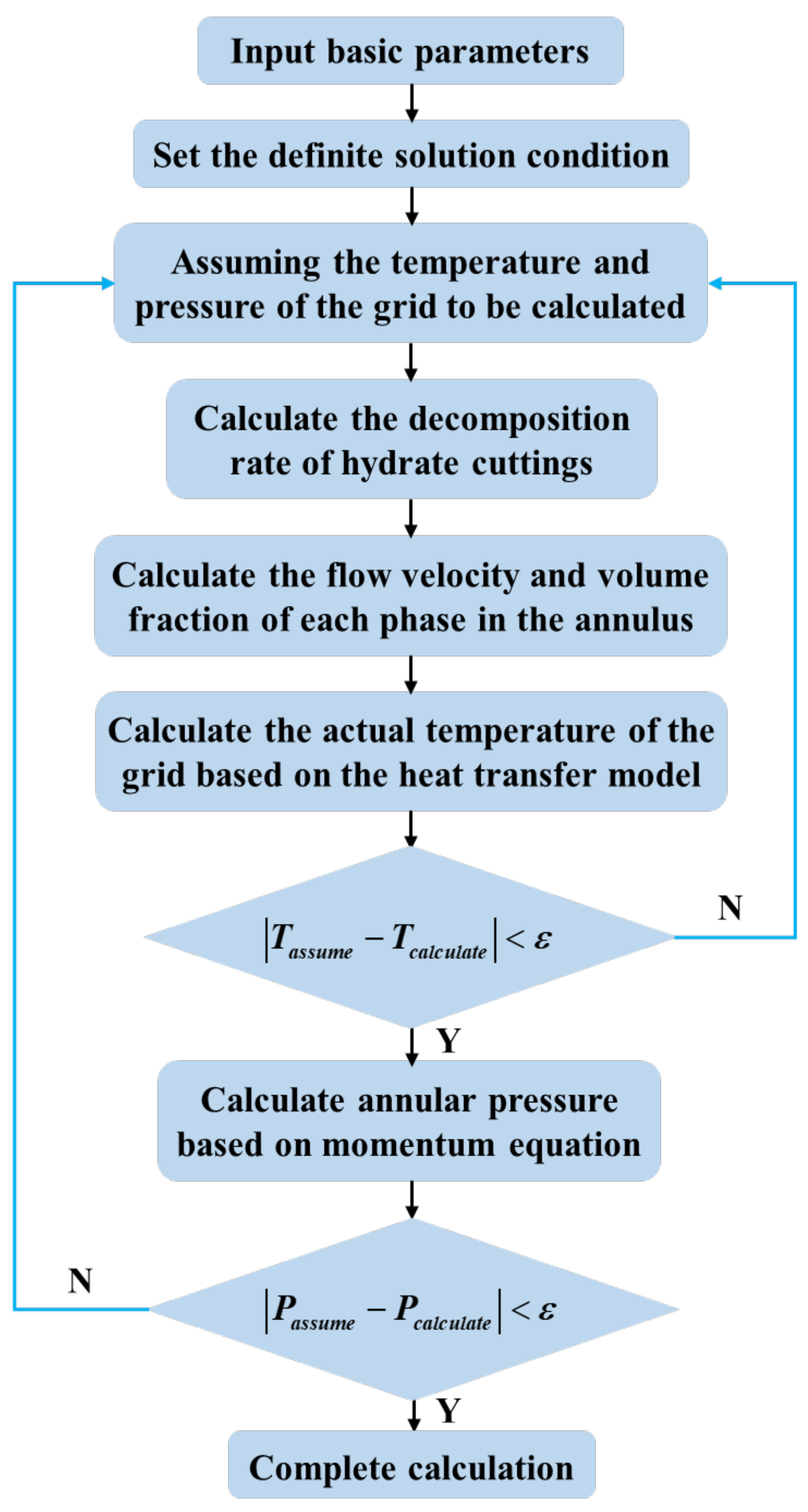



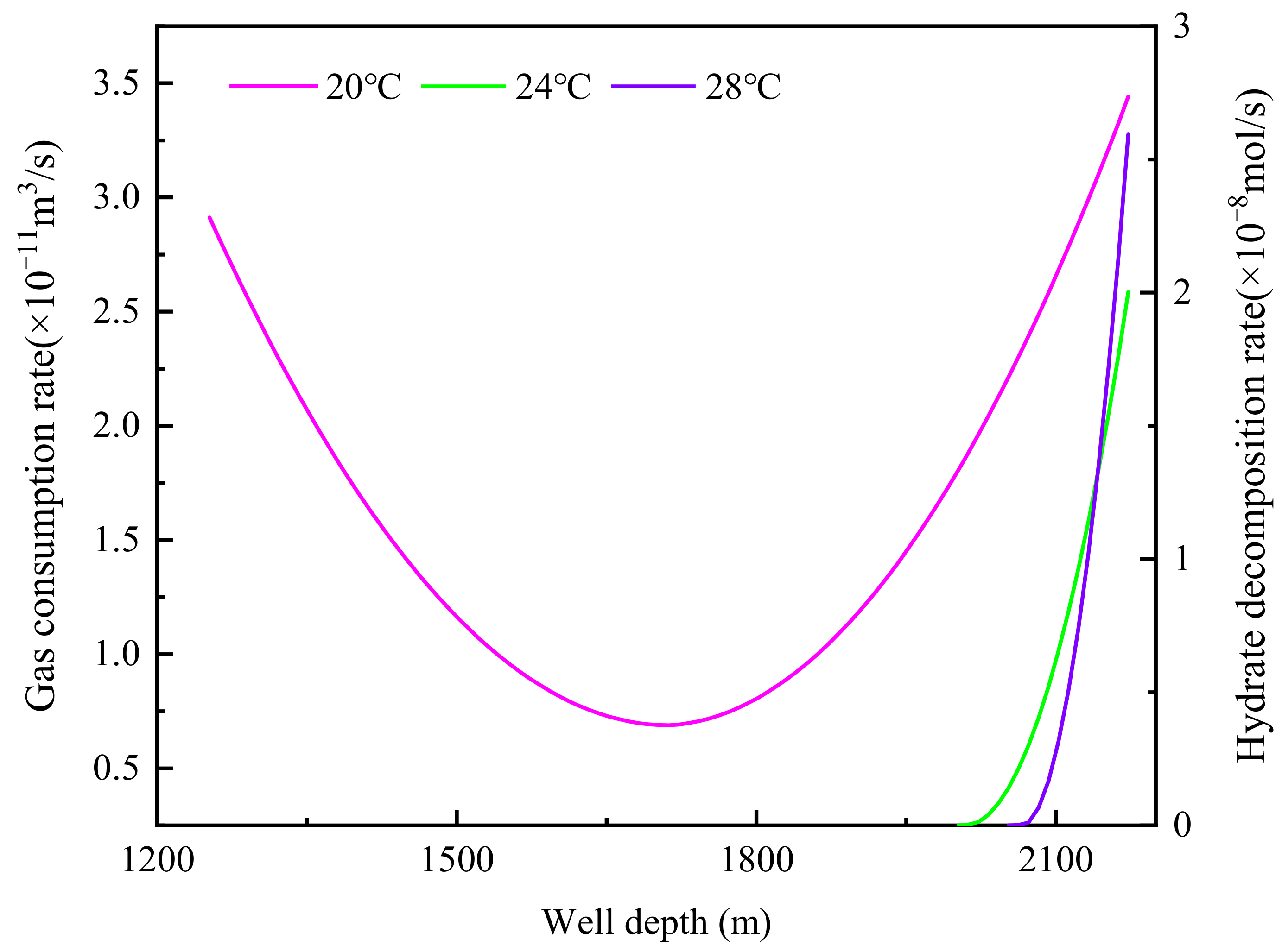
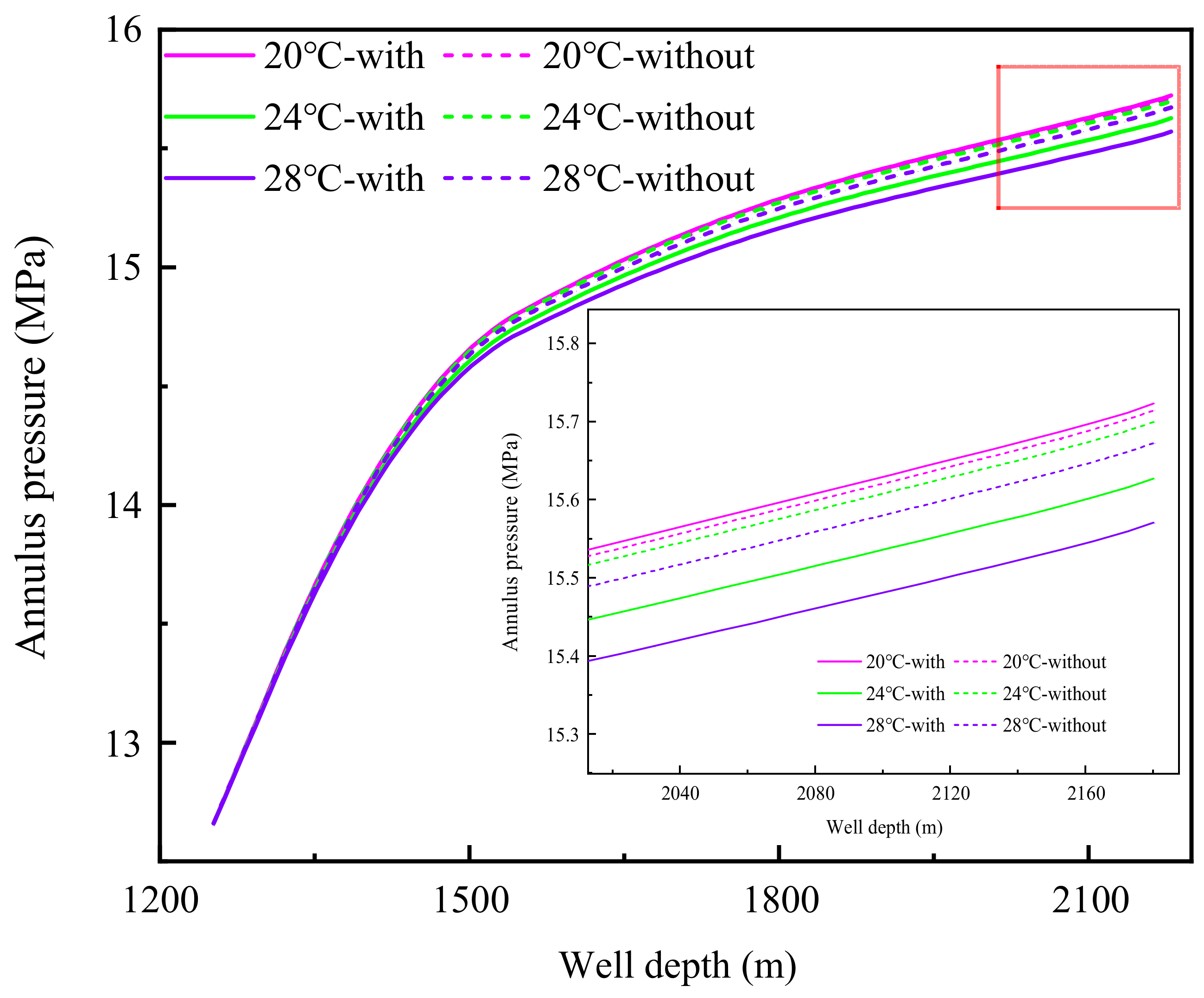
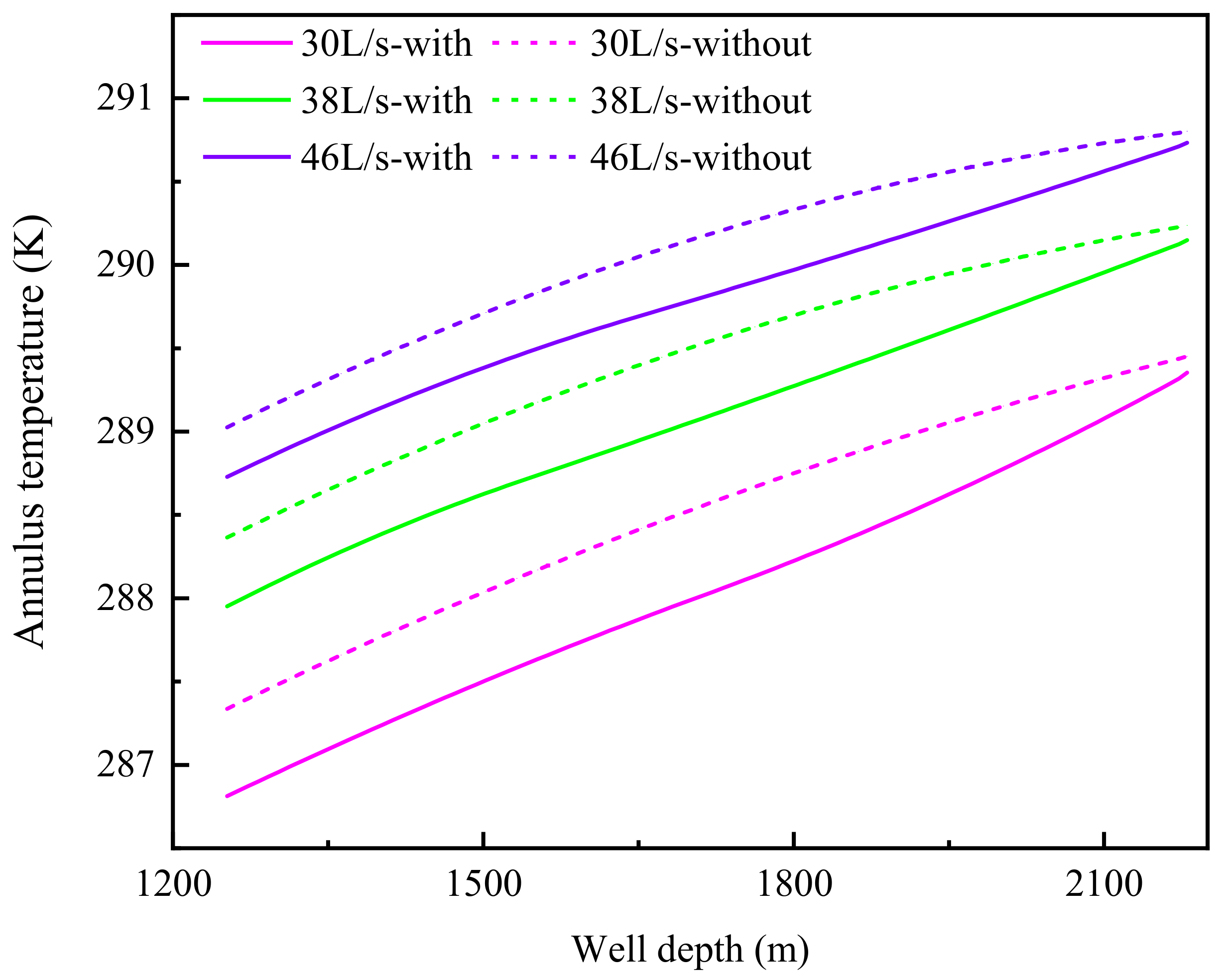
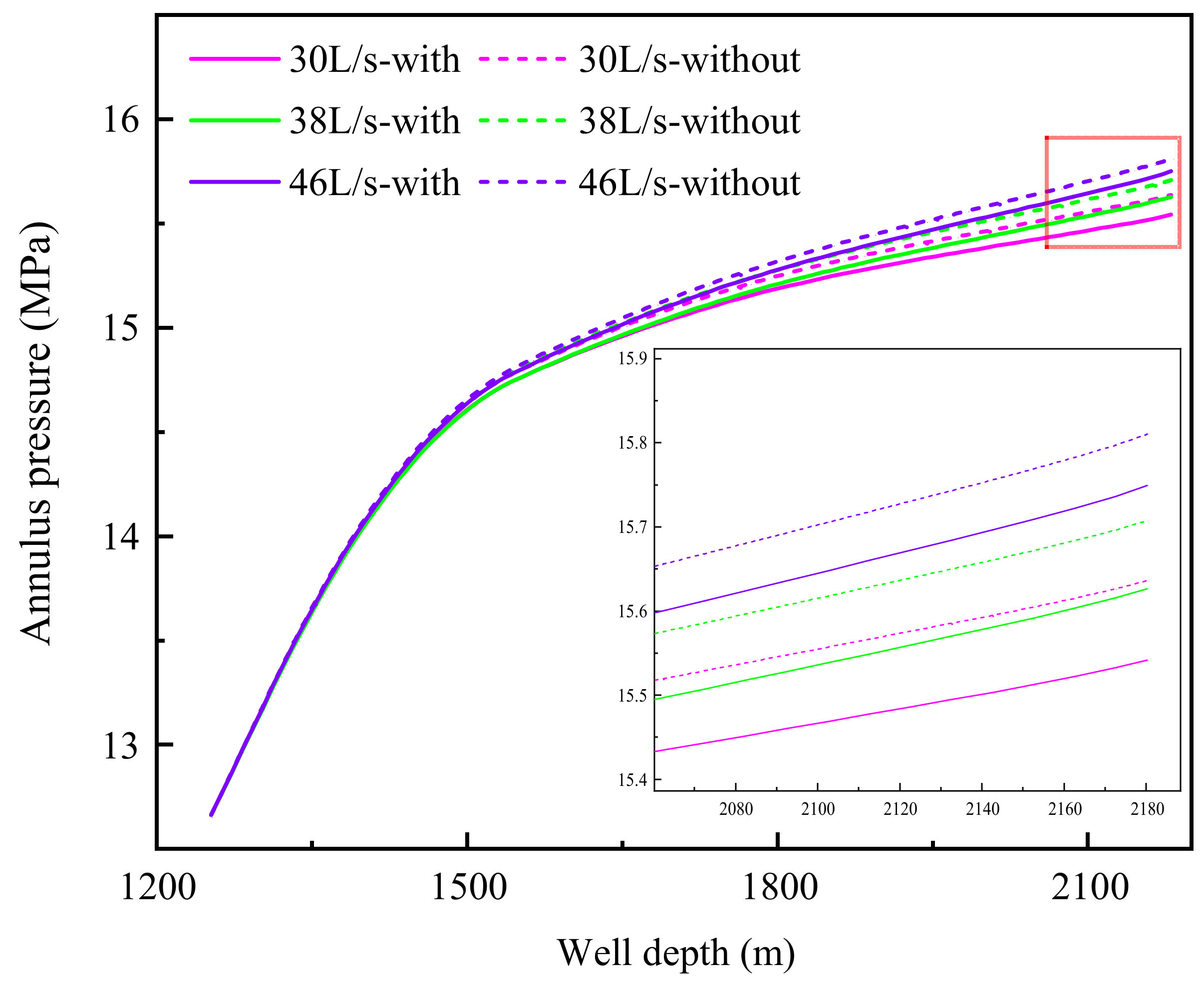
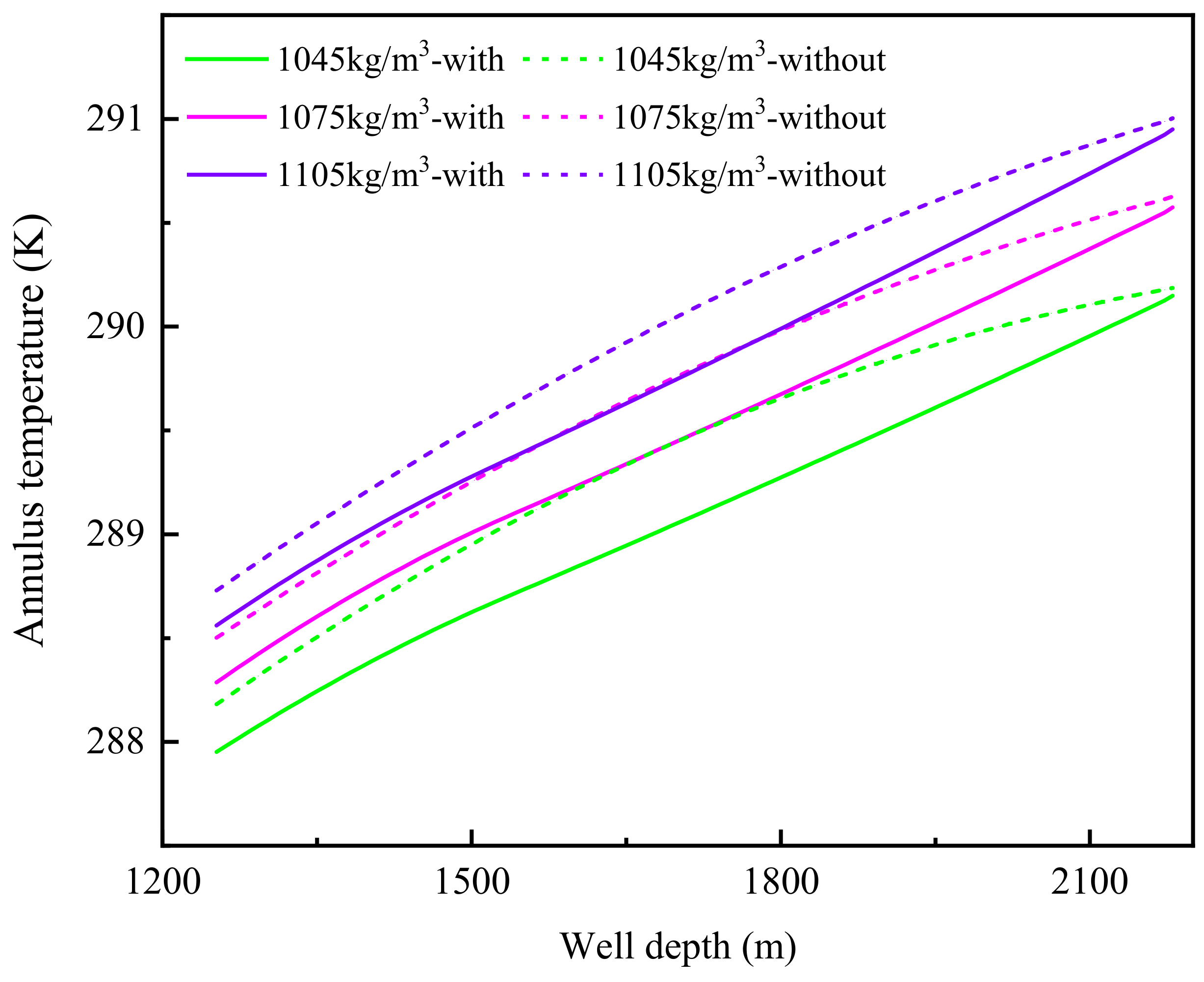

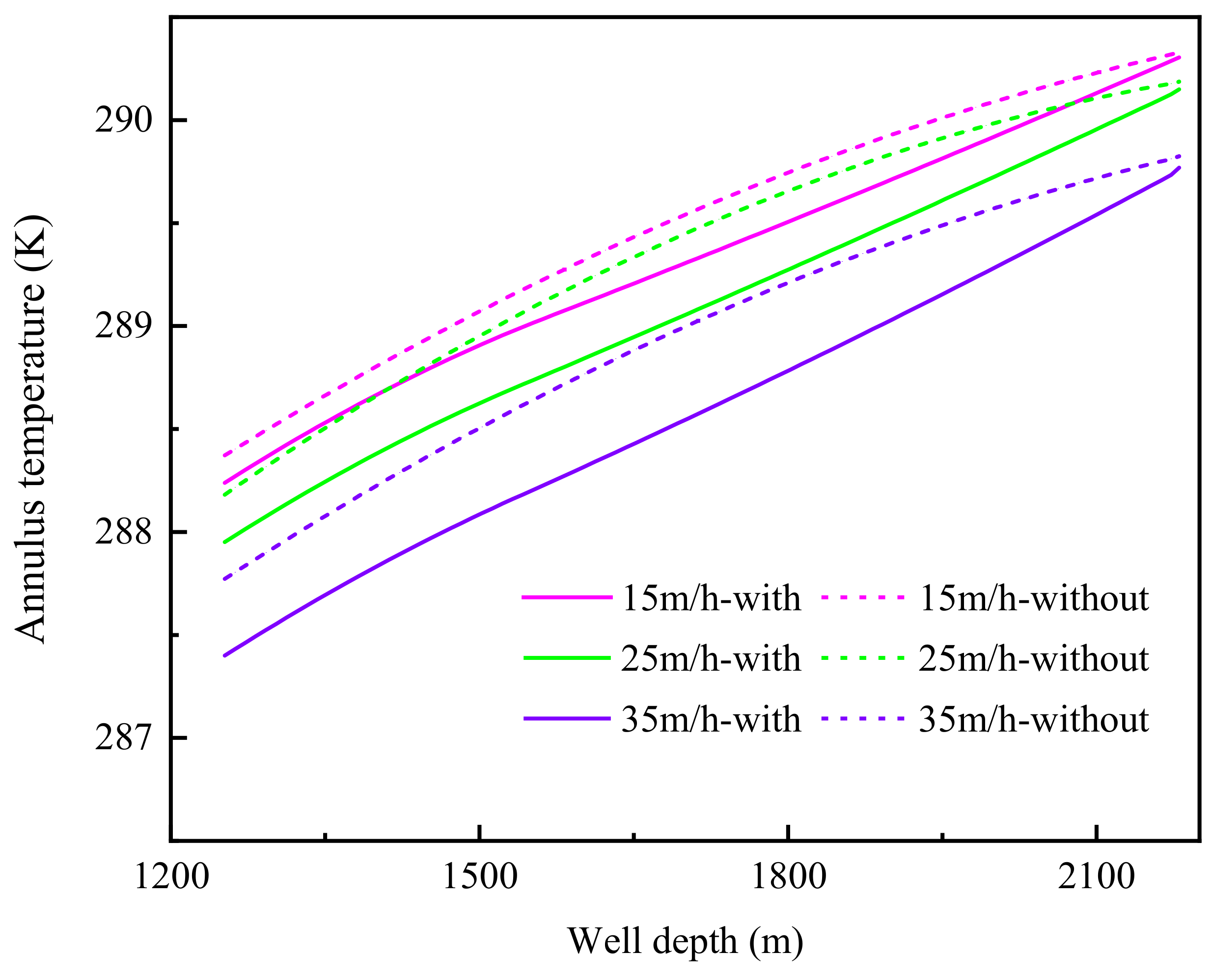
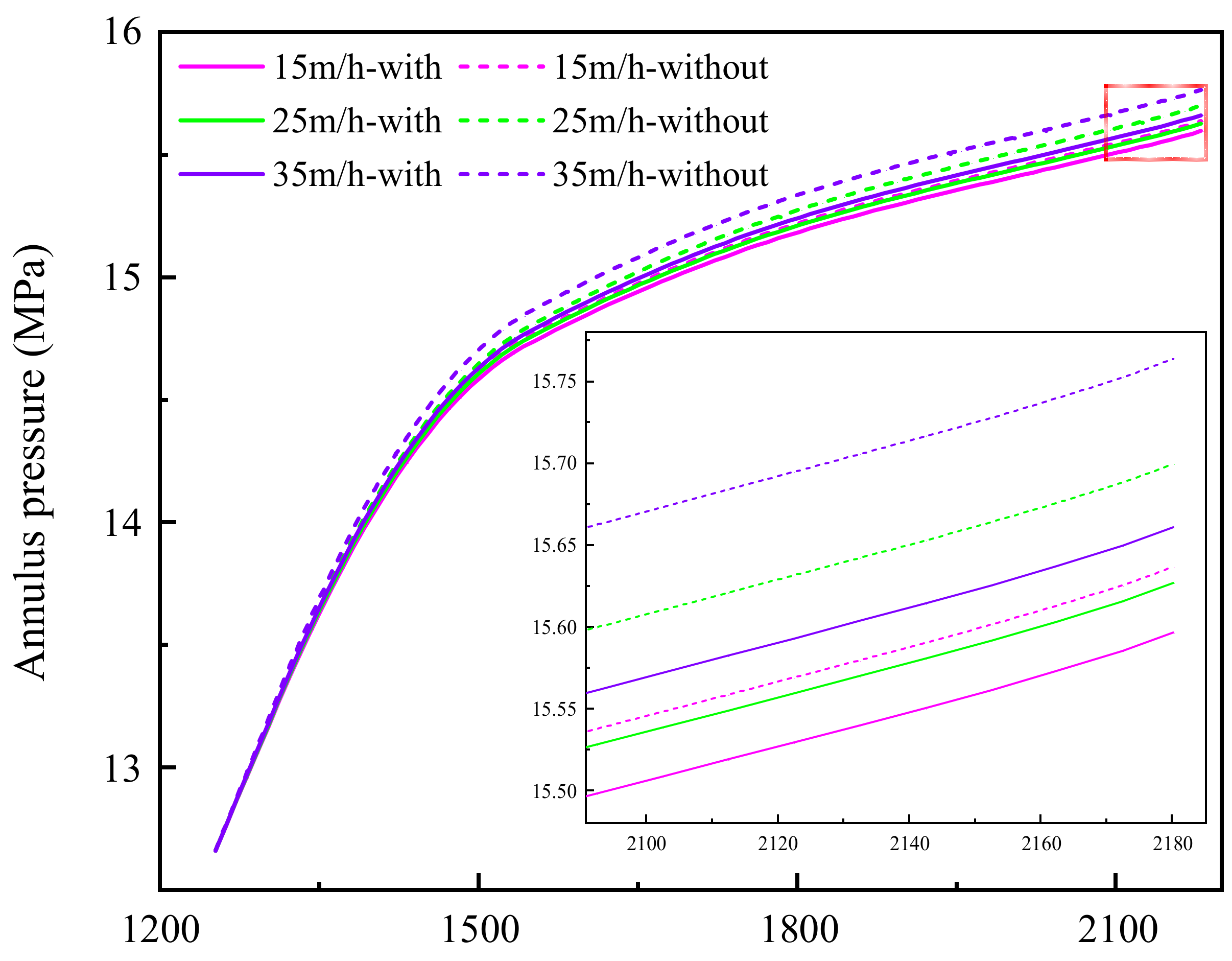
| Parameter | Value | Parameter | Value |
|---|---|---|---|
| Mudline temperature, °C | 3.6 | Rate of penetration, m | 25 |
| Geothermal gradient, °C·m−1 | 0.047 | Hydrate density, kg·m−3 | 910 |
| Drilling fluid density, kg·m−3 | 1045 | Salinity of drilling fluid, % | 5.0 |
| Drilling fluid displacement, L·min | 2280 | Formation thermal conductivity, W·m−1·°C−1 | 2.25 |
| Drilling fluid inlet temperature, °C | 24 | Thermal conductivity of drill pipe, W·m−1·°C−1 | 43.75 |
| Initial viscosity of drilling fluid, mPa·s | 12 | Thermal conductivity of drilling fluid, W·m−1·°C−1 | 0.60 |
| Hydrate saturation of hydrate layer, % | 31.0 | Specific heat capacity of drilling fluid, J·kg−1·°C−1 | 3930 |
| Hydrate saturation of three-phase layer, % | 11.7 | Phase equilibrium translation coefficient | 24.0 |
| Gas saturation of three-phase layer, % | 13.2 | Average diameter of cuttings, mm | 8 |
| Inside diameter of drill collar, m | 0.073 | Inside diameter of drill pipe, m | 0.121 |
| Outside diameter of drill collar, m | 0.165 | Outside diameter of drill pipe, m | 0.139 |
Disclaimer/Publisher’s Note: The statements, opinions and data contained in all publications are solely those of the individual author(s) and contributor(s) and not of MDPI and/or the editor(s). MDPI and/or the editor(s) disclaim responsibility for any injury to people or property resulting from any ideas, methods, instructions or products referred to in the content. |
© 2023 by the authors. Licensee MDPI, Basel, Switzerland. This article is an open access article distributed under the terms and conditions of the Creative Commons Attribution (CC BY) license (https://creativecommons.org/licenses/by/4.0/).
Share and Cite
Yin, F.; Ni, X.; Han, J.; Di, J.; Zhou, Y.; Zhao, X.; Gao, Y. Impact Assessment of Hydrate Cuttings Migration and Decomposition on Annular Temperature and Pressure in Deep Water Gas Hydrate Formation Riserless Drilling. Energies 2023, 16, 5903. https://doi.org/10.3390/en16165903
Yin F, Ni X, Han J, Di J, Zhou Y, Zhao X, Gao Y. Impact Assessment of Hydrate Cuttings Migration and Decomposition on Annular Temperature and Pressure in Deep Water Gas Hydrate Formation Riserless Drilling. Energies. 2023; 16(16):5903. https://doi.org/10.3390/en16165903
Chicago/Turabian StyleYin, Faling, Xingyu Ni, Jindong Han, Jianwei Di, Youwei Zhou, Xinxin Zhao, and Yonghai Gao. 2023. "Impact Assessment of Hydrate Cuttings Migration and Decomposition on Annular Temperature and Pressure in Deep Water Gas Hydrate Formation Riserless Drilling" Energies 16, no. 16: 5903. https://doi.org/10.3390/en16165903
APA StyleYin, F., Ni, X., Han, J., Di, J., Zhou, Y., Zhao, X., & Gao, Y. (2023). Impact Assessment of Hydrate Cuttings Migration and Decomposition on Annular Temperature and Pressure in Deep Water Gas Hydrate Formation Riserless Drilling. Energies, 16(16), 5903. https://doi.org/10.3390/en16165903






